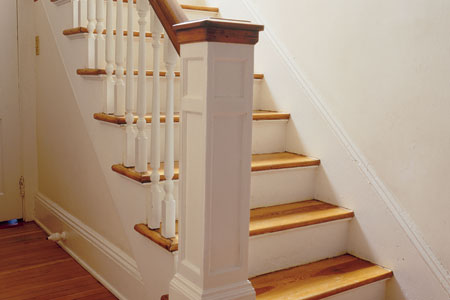Click image for larger version
Musical Idioms
Unique loft XVII century

This unique loft is located in a 17th century building in central Stockholm, Sweden. Previously, there was placed kofeobzharochnaya factory, and later – an architectural office. Today, the charming elements of the original architecture intelligently decorated with modern materials that give a unique character of the building area of 118 sq.m. Wooden beams on the ceiling, concrete walls, furniture volume, open-plan living area create a warm and welcoming atmosphere.








How to Replace a Baluster
Photo: Kolin Smith
Q: I have an old stairway with several broken wood balusters. How do I replace them? —S. Christopher Hunter, Ypsilanti, MIch.
David Raymond, owner, Raymond Design Builders, replies: A stair with missing balusters is not only unsafe, particularly for children, it’s about as attractive as a hockey goalie’s grin. Fortunately, replacing them is fairly easy for anyone who can use a miter saw. It just requires some advance work.
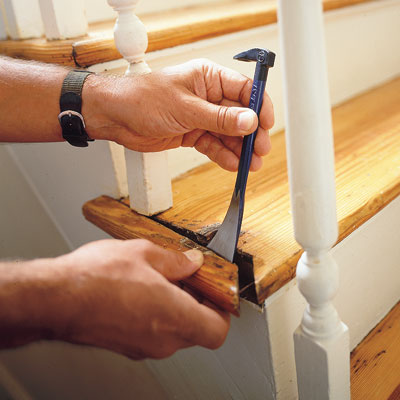 First, you have to find new balusters that match your existing ones. It’s unlikely that a home center will have what you need, but companies that specialize in building stairs or making stair parts, such as Harmonson Stairs, can often turn an identical one for you on a lathe. You’ll need to supply a sample or two, intact if possible. For paint- grade work, maple is ideal because it’s strong and smooth. For stain-grade balusters, ask the company to match the species, too.
First, you have to find new balusters that match your existing ones. It’s unlikely that a home center will have what you need, but companies that specialize in building stairs or making stair parts, such as Harmonson Stairs, can often turn an identical one for you on a lathe. You’ll need to supply a sample or two, intact if possible. For paint- grade work, maple is ideal because it’s strong and smooth. For stain-grade balusters, ask the company to match the species, too.
Finish the new balusters before you install them, either with paint or polyurethane, then follow these steps to get your stairway back in shape.
Read the rest here at ThisOldHouse.com
Where Housing Is Headed
Click image for interactive graphs
The inventory of unsold homes has declined sharply from one year ago in many markets. While price declines and low mortgage rates have pushed affordability to its best level in the past decade, the prospect of falling prices, more foreclosures, and economic uncertainty continues to hold back demand. — November 2011
Home prices and mortgage rates have fallen so far that the monthly cost of owning a home is more affordable than at any point in the past 15 years and is less expensive than renting in a growing number of cities.
 The Wall Street Journal’s third-quarter survey of housing-market conditions in 28 of the nation’s largest metropolitan areas found that home values declined in all but five markets compared with the second quarter, according to data from Zillow Inc. Meanwhile, rent levels have risen briskly across the country and mortgage rates, hovering around 4%, are the lowest in six decades.
The Wall Street Journal’s third-quarter survey of housing-market conditions in 28 of the nation’s largest metropolitan areas found that home values declined in all but five markets compared with the second quarter, according to data from Zillow Inc. Meanwhile, rent levels have risen briskly across the country and mortgage rates, hovering around 4%, are the lowest in six decades.
Read the rest here.
Measuring the health of the economy with the Men’s Underwear Index
The Men’s Underwear Index (MUI)
Did you know that some economists look to the underwear drawers of American men to determine the health of the current economy? The Men’s Underwear Index (MUI) is an unconventional economic indicator that measures how the economy is performing based on the sales of men’s underwear. We’re not making this up, we swear!
The logic behind the MUI is that because men’s underwear is a necessity, not a luxury, sales are steady, but when the health of the economy is poor, sales dip as the necessity becomes a luxury. When sales improve, the health of the economy is said to improve along with it, according to subscribers of the MUI theory.
It isn’t just crackpot economists smoking a pipe full of pretentiousness, no, even former Federal Reserve Chairman Alan Greenspan was a believer in the MUI. He said that because so few people ever see men’s underpants, this is the first thing men stop buying in a down economy.
So how is the MUI right now? As of August, men’s underwear sales rose 7.9 percent from August 2011, according the retail research firm NPD Group, indicating that while we are down substantially from past years, the improvement is in line with other economic indicators that claim the economy has not recovered but is showing signs of doing so, thus at least for now, the MUI is on course.
Critics argue that it is typically women that buy underwear for men, thus the MUI is bunk, and other critics say the theory is flawed because men wear underwear until the holes are too big to stand, thus it does not correlate to the economy.
How to Clear Any Clogged Drain
Photo: Merle Henkenius
Roto-Rooter reports that that day after Thanksgiving is the single busiest day of the year for their service technicians. Armed with the right tools and techniques, you can easily unplug stopped-up drains without having to call in a pro. All plumbing systems develop clogs—there’s no way to avoid it. We’ll show you how to clear stubborn clogs in a kitchen sink, bathtub, toilet and floor drain. These proven techniques will dislodge virtually any clog. If you can’t clear a clog after a few attempts, make sure you admit defeat and turn the job over to a drain-cleaning service or licensed plumber. Exerting too much force can permanently damage a pipe or fixture.
That said, specialized plumbing tools used to combat clogs are affordable, and they’re available at any hardware store or home center; you can even rent some.
-
The first tool to reach for when trouble arises is a plunger. This plumber’s friend clears clogs from most fixtures, including sinks, tubs and toilets. Every homeowner should keep one handy.
-
To dislodge clogs located farther down the drainpipe, use a cable auger, or plumber’s snake, a long, flexible steel cable wound around a spool that’s fitted with a hand crank. Cable augers are available in lengths up to 100 feet, though a 25-foot model will suffice for most any household clog.
-
A closet auger is specifically made for snaking out toilets. It, too, is equipped with a hand crank, but instead of a spool, the cable is encased in a rigid shaft. The auger end is bent at a precise angle to fit through the tight curves of a toilet trap.
-
For a very large clog or one that’s far from the fixture, rent an electric power auger. This machine—basically a large cable auger powered by an electric motor—is very effective at cutting through virtually any clog, even tangled tree roots. Before bringing home a power auger, be sure the rental agent shows you how to safely dispense and retrieve the cable.
Drawbridge-Style Stairs Treehouse Retreat

Like something out of a classic storybook – or modern zombie movie, perhaps – the stairs leading up too this treehouse can be pulled up mechanically to isolate the home and upper deck (both a full floor above the ground), in turn letting residents sleep tight inside and worry less when away.
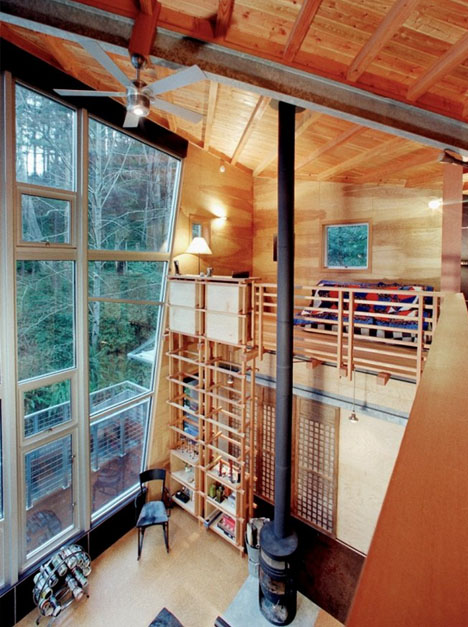
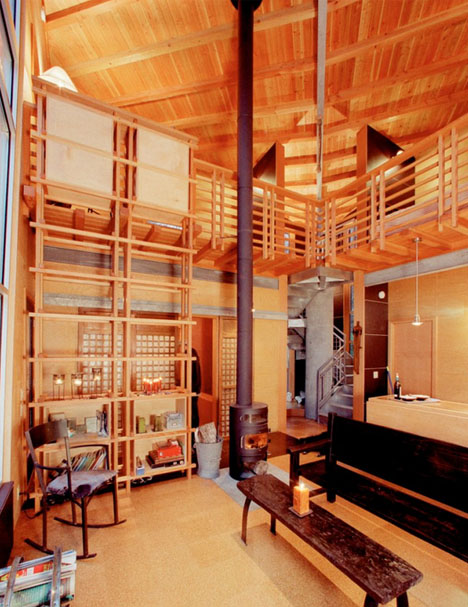
Located along the Hood Canal in western Washington state, this towering vacation cabin by Castanes Architects is only eight hundred square feet, but feels massive thanks to its tall multi-story interior and huge waterfront-facing windows.

The exterior is comprised clear-sealed cedar and fiber cement panels while the interior features light birch plywood, raw spiral concrete-and-metal stairs and stainless steel details.
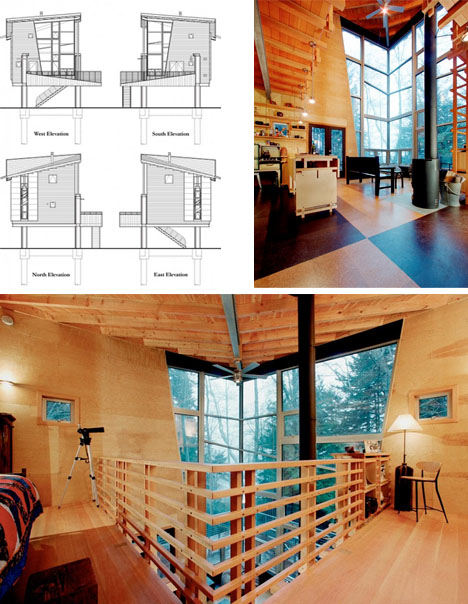
From within, the sharp-angled front seems to carve a clearing through the trees to create space for forward views, drawing inside eyes ever outward, while two-story architectural elements tie the first and second stories together, visually connecting the entire space.
75 Easy Spruce-Ups Under $75
1. Wallpaper an Alcove
Highlight an alcove by wallpapering the back wall.
Similar to shown: Fern Damask prepasted wallpaper, $44 for a 60-square-foot roll; yorkwall.com
2. Create an In-Window Kitchen Herb Garden
Screw 1×4 wood cleats to the side jambs and insert tempered glass shelves. Two 3-inch-deep shelves for a standard 30-inch double-hung, $64;dullesglassandmirror.com
Read the rest at ThisOldHouse.com
Facebook makes everyone 4.74 degrees apart
 Facebook has given us reason to celebrate: we’re all a little bit closer to Kevin Bacon. While playing a round of “4.74 Degrees of Kevin Bacon” doesn’t have quite the same ring to it, a new study claims everyone on Earth is separated by just 4.74 degrees.
Facebook has given us reason to celebrate: we’re all a little bit closer to Kevin Bacon. While playing a round of “4.74 Degrees of Kevin Bacon” doesn’t have quite the same ring to it, a new study claims everyone on Earth is separated by just 4.74 degrees.
Facebook conducted the study in partnership with the University of Milan, tracking the connections of its 721 million members. The researchers found that a person could be connected to a randomly selected individual through an average of 4.74 links. That number drops to 4.37 in the United States.
“When considering even the most distant Facebook user in the Siberian tundra or the Peruvian rain forest,” Facebook shared on its blog, “a friend of your friend probably knows a friend of their friend.”
Read the complete report on facebook here.

